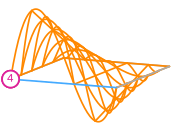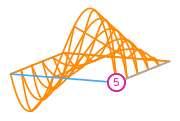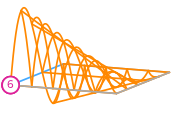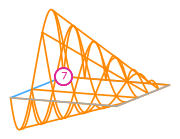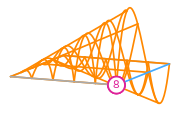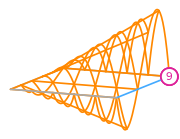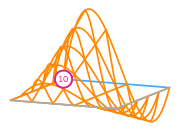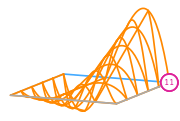an encyclopedia of finite element definitions
Degree 3 serendipity on a quadrilateral
◀ Back to serendipity definition page
- \(R\) is the reference quadrilateral. The following numbering of the subentities of the reference is used:
- \(\mathcal{V}\) is spanned by: \(1\), \(x\), \(x^{2}\), \(x^{3}\), \(y\), \(x y\), \(x^{2} y\), \(y^{2}\), \(x y^{2}\), \(y^{3}\), \(x y^{3}\), \(x^{3} y\)
- \(\mathcal{L}=\{l_0,...,l_{11}\}\)
- Functionals and basis functions:

\(\displaystyle l_{0}:v\mapsto v(0,0)\)
\(\displaystyle \phi_{0} = 10 x^{3} y - 10 x^{3} - 18 x^{2} y + 18 x^{2} + 10 x y^{3} - 18 x y^{2} + 17 x y - 9 x - 10 y^{3} + 18 y^{2} - 9 y + 1\)
This DOF is associated with vertex 0 of the reference element.
\(\displaystyle \phi_{0} = 10 x^{3} y - 10 x^{3} - 18 x^{2} y + 18 x^{2} + 10 x y^{3} - 18 x y^{2} + 17 x y - 9 x - 10 y^{3} + 18 y^{2} - 9 y + 1\)
This DOF is associated with vertex 0 of the reference element.
\(\displaystyle l_{1}:v\mapsto v(1,0)\)
\(\displaystyle \phi_{1} = x \left(- 10 x^{2} y + 10 x^{2} + 12 x y - 12 x - 10 y^{3} + 18 y^{2} - 11 y + 3\right)\)
This DOF is associated with vertex 1 of the reference element.
\(\displaystyle \phi_{1} = x \left(- 10 x^{2} y + 10 x^{2} + 12 x y - 12 x - 10 y^{3} + 18 y^{2} - 11 y + 3\right)\)
This DOF is associated with vertex 1 of the reference element.
\(\displaystyle l_{2}:v\mapsto v(0,1)\)
\(\displaystyle \phi_{2} = y \left(- 10 x^{3} + 18 x^{2} - 10 x y^{2} + 12 x y - 11 x + 10 y^{2} - 12 y + 3\right)\)
This DOF is associated with vertex 2 of the reference element.
\(\displaystyle \phi_{2} = y \left(- 10 x^{3} + 18 x^{2} - 10 x y^{2} + 12 x y - 11 x + 10 y^{2} - 12 y + 3\right)\)
This DOF is associated with vertex 2 of the reference element.
\(\displaystyle l_{3}:v\mapsto v(1,1)\)
\(\displaystyle \phi_{3} = x y \left(10 x^{2} - 12 x + 10 y^{2} - 12 y + 5\right)\)
This DOF is associated with vertex 3 of the reference element.
\(\displaystyle \phi_{3} = x y \left(10 x^{2} - 12 x + 10 y^{2} - 12 y + 5\right)\)
This DOF is associated with vertex 3 of the reference element.
\(\displaystyle l_{4}:v\mapsto\displaystyle\int_{e_{0}}(1 - s_{0})v\)
where \(e_{0}\) is the 0th edge;
and \(s_{0},s_{1}\) is a parametrisation of \(e_{0}\).
\(\displaystyle \phi_{4} = 12 x \left(- 5 x^{2} y + 5 x^{2} + 8 x y - 8 x - 3 y + 3\right)\)
This DOF is associated with edge 0 of the reference element.
where \(e_{0}\) is the 0th edge;
and \(s_{0},s_{1}\) is a parametrisation of \(e_{0}\).
\(\displaystyle \phi_{4} = 12 x \left(- 5 x^{2} y + 5 x^{2} + 8 x y - 8 x - 3 y + 3\right)\)
This DOF is associated with edge 0 of the reference element.
\(\displaystyle l_{5}:v\mapsto\displaystyle\int_{e_{0}}(s_{0})v\)
where \(e_{0}\) is the 0th edge;
and \(s_{0},s_{1}\) is a parametrisation of \(e_{0}\).
\(\displaystyle \phi_{5} = 12 x \left(5 x^{2} y - 5 x^{2} - 7 x y + 7 x + 2 y - 2\right)\)
This DOF is associated with edge 0 of the reference element.
where \(e_{0}\) is the 0th edge;
and \(s_{0},s_{1}\) is a parametrisation of \(e_{0}\).
\(\displaystyle \phi_{5} = 12 x \left(5 x^{2} y - 5 x^{2} - 7 x y + 7 x + 2 y - 2\right)\)
This DOF is associated with edge 0 of the reference element.
\(\displaystyle l_{6}:v\mapsto\displaystyle\int_{e_{1}}(1 - s_{0})v\)
where \(e_{1}\) is the 1st edge;
and \(s_{0},s_{1}\) is a parametrisation of \(e_{1}\).
\(\displaystyle \phi_{6} = 12 y \left(- 5 x y^{2} + 8 x y - 3 x + 5 y^{2} - 8 y + 3\right)\)
This DOF is associated with edge 1 of the reference element.
where \(e_{1}\) is the 1st edge;
and \(s_{0},s_{1}\) is a parametrisation of \(e_{1}\).
\(\displaystyle \phi_{6} = 12 y \left(- 5 x y^{2} + 8 x y - 3 x + 5 y^{2} - 8 y + 3\right)\)
This DOF is associated with edge 1 of the reference element.
\(\displaystyle l_{7}:v\mapsto\displaystyle\int_{e_{1}}(s_{0})v\)
where \(e_{1}\) is the 1st edge;
and \(s_{0},s_{1}\) is a parametrisation of \(e_{1}\).
\(\displaystyle \phi_{7} = 12 y \left(5 x y^{2} - 7 x y + 2 x - 5 y^{2} + 7 y - 2\right)\)
This DOF is associated with edge 1 of the reference element.
where \(e_{1}\) is the 1st edge;
and \(s_{0},s_{1}\) is a parametrisation of \(e_{1}\).
\(\displaystyle \phi_{7} = 12 y \left(5 x y^{2} - 7 x y + 2 x - 5 y^{2} + 7 y - 2\right)\)
This DOF is associated with edge 1 of the reference element.
\(\displaystyle l_{8}:v\mapsto\displaystyle\int_{e_{2}}(1 - s_{0})v\)
where \(e_{2}\) is the 2nd edge;
and \(s_{0},s_{1}\) is a parametrisation of \(e_{2}\).
\(\displaystyle \phi_{8} = 12 x y \left(5 y^{2} - 8 y + 3\right)\)
This DOF is associated with edge 2 of the reference element.
where \(e_{2}\) is the 2nd edge;
and \(s_{0},s_{1}\) is a parametrisation of \(e_{2}\).
\(\displaystyle \phi_{8} = 12 x y \left(5 y^{2} - 8 y + 3\right)\)
This DOF is associated with edge 2 of the reference element.
\(\displaystyle l_{9}:v\mapsto\displaystyle\int_{e_{2}}(s_{0})v\)
where \(e_{2}\) is the 2nd edge;
and \(s_{0},s_{1}\) is a parametrisation of \(e_{2}\).
\(\displaystyle \phi_{9} = 12 x y \left(- 5 y^{2} + 7 y - 2\right)\)
This DOF is associated with edge 2 of the reference element.
where \(e_{2}\) is the 2nd edge;
and \(s_{0},s_{1}\) is a parametrisation of \(e_{2}\).
\(\displaystyle \phi_{9} = 12 x y \left(- 5 y^{2} + 7 y - 2\right)\)
This DOF is associated with edge 2 of the reference element.
\(\displaystyle l_{10}:v\mapsto\displaystyle\int_{e_{3}}(1 - s_{0})v\)
where \(e_{3}\) is the 3rd edge;
and \(s_{0},s_{1}\) is a parametrisation of \(e_{3}\).
\(\displaystyle \phi_{10} = 12 x y \left(5 x^{2} - 8 x + 3\right)\)
This DOF is associated with edge 3 of the reference element.
where \(e_{3}\) is the 3rd edge;
and \(s_{0},s_{1}\) is a parametrisation of \(e_{3}\).
\(\displaystyle \phi_{10} = 12 x y \left(5 x^{2} - 8 x + 3\right)\)
This DOF is associated with edge 3 of the reference element.




